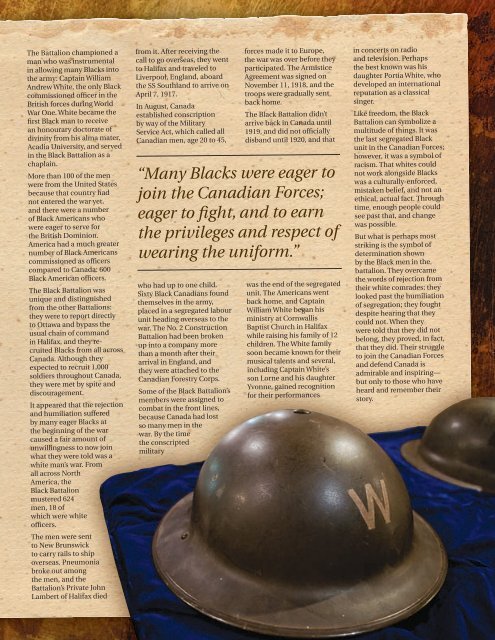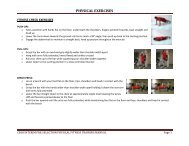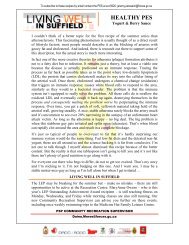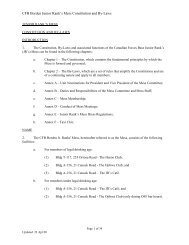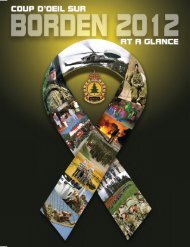We Care!
We Care!
We Care!
You also want an ePaper? Increase the reach of your titles
YUMPU automatically turns print PDFs into web optimized ePapers that Google loves.
The Battalion championed a<br />
man who was instrumental<br />
in allowing many Blacks into<br />
the army: Captain William<br />
Andrew White, the only Black<br />
commissioned officer in the<br />
British forces during World<br />
War One. White became the<br />
first Black man to receive<br />
an honourary doctorate of<br />
divinity from his alma mater,<br />
Acadia University, and served<br />
in the Black Battalion as a<br />
chaplain.<br />
More than 100 of the men<br />
were from the United States<br />
because that country had<br />
not entered the war yet,<br />
and there were a number<br />
of Black Americans who<br />
were eager to serve for<br />
the British Dominion.<br />
America had a much greater<br />
number of Black Americans<br />
commissioned as officers<br />
compared to Canada: 600<br />
Black American officers.<br />
The Black Battalion was<br />
unique and distinguished<br />
from the other Battalions:<br />
they were to report directly<br />
to Ottawa and bypass the<br />
usual chain of command<br />
in Halifax, and they recruited<br />
Blacks from all across<br />
Canada. Although they<br />
expected to recruit 1,000<br />
soldiers throughout Canada,<br />
they were met by spite and<br />
discouragement.<br />
It appeared that the rejection<br />
and humiliation suffered<br />
by many eager Blacks at<br />
the beginning of the war<br />
caused a fair amount of<br />
unwillingness to now join<br />
what they were told was a<br />
white man’s war. From<br />
all across North<br />
America, the<br />
Black Battalion<br />
mustered 624<br />
men, 18 of<br />
which were white<br />
officers.<br />
The men were sent<br />
to New Brunswick<br />
to carry rails to ship<br />
overseas. Pneumonia<br />
broke out among<br />
the men, and the<br />
Battalion’s Private John<br />
Lambert of Halifax died<br />
from it. After receiving the<br />
call to go overseas, they went<br />
to Halifax and traveled to<br />
Liverpool, England, aboard<br />
the SS Southland to arrive on<br />
April 7, 1917.<br />
In August, Canada<br />
established conscription<br />
by way of the Military<br />
Service Act, which called all<br />
Canadian men, age 20 to 45,<br />
forces made it to Europe,<br />
the war was over before they<br />
participated. The Armistice<br />
Agreement was signed on<br />
November 11, 1918, and the<br />
troops were gradually sent<br />
back home.<br />
The Black Battalion didn’t<br />
arrive back in Canada until<br />
1919, and did not officially<br />
disband until 1920, and that<br />
“Many Blacks were eager to<br />
join the Canadian Forces;<br />
eager to fight, and to earn<br />
the privileges and respect of<br />
wearing the uniform.”<br />
who had up to one child.<br />
Sixty Black Canadians found<br />
themselves in the army,<br />
placed in a segregated labour<br />
unit heading overseas to the<br />
war. The No. 2 Construction<br />
Battalion had been broken<br />
up into a company more<br />
than a month after their<br />
arrival in England, and<br />
they were attached to the<br />
Canadian Forestry Corps.<br />
Some of the Black Battalion’s<br />
members were assigned to<br />
combat in the front lines,<br />
because Canada had lost<br />
so many men in the<br />
war. By the time<br />
the conscripted<br />
military<br />
was the end of the segregated<br />
unit. The Americans went<br />
back home, and Captain<br />
William White began his<br />
ministry at Cornwallis<br />
Baptist Church in Halifax<br />
while raising his family of 12<br />
children. The White family<br />
soon became known for their<br />
musical talents and several,<br />
including Captain White’s<br />
son Lorne and his daughter<br />
Yvonne, gained recognition<br />
for their performances<br />
in concerts on radio<br />
and television. Perhaps<br />
the best known was his<br />
daughter Portia White, who<br />
developed an international<br />
reputation as a classical<br />
singer.<br />
Like freedom, the Black<br />
Battalion can symbolize a<br />
multitude of things. It was<br />
the last segregated Black<br />
unit in the Canadian Forces;<br />
however, it was a symbol of<br />
racism. That whites could<br />
not work alongside Blacks<br />
was a culturally-enforced,<br />
mistaken belief, and not an<br />
ethical, actual fact. Through<br />
time, enough people could<br />
see past that, and change<br />
was possible.<br />
But what is perhaps most<br />
striking is the symbol of<br />
determination shown<br />
by the Black men in the<br />
battalion. They overcame<br />
the words of rejection from<br />
their white comrades; they<br />
looked past the humiliation<br />
of segregation; they fought<br />
despite hearing that they<br />
could not. When they<br />
were told that they did not<br />
belong, they proved, in fact,<br />
that they did. Their struggle<br />
to join the Canadian Forces<br />
and defend Canada is<br />
admirable and inspiring—<br />
but only to those who have<br />
heard and remember their<br />
story.


